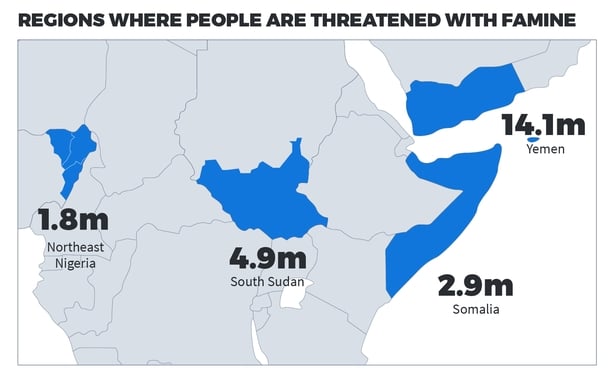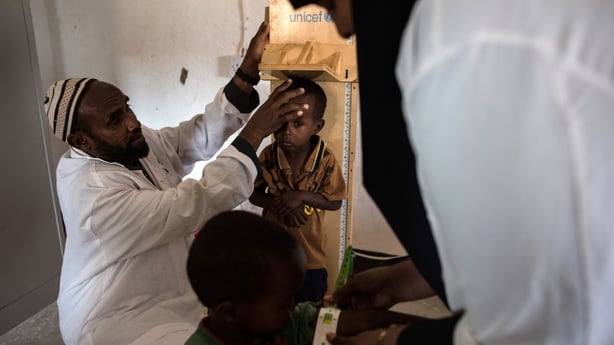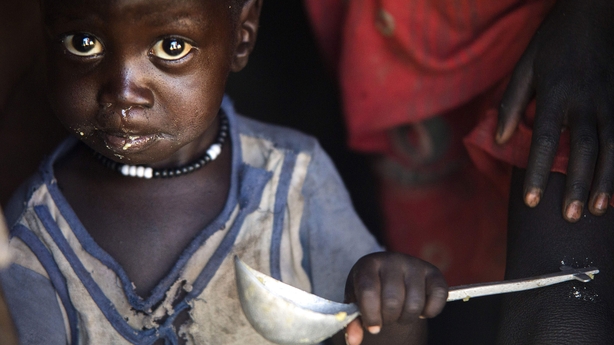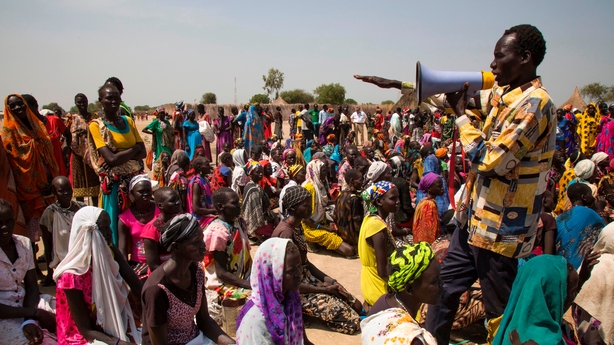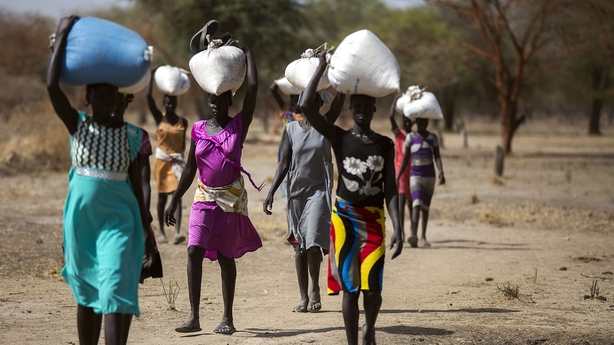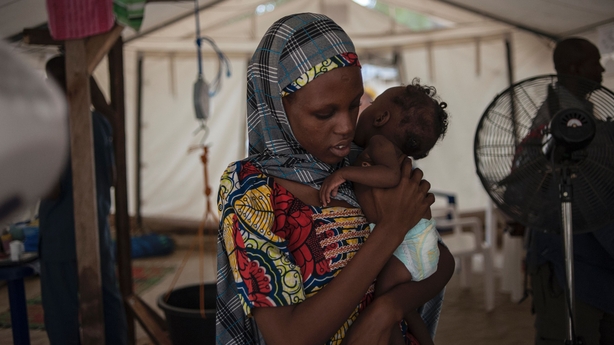
A Somali boy sits outside his makeshift hut at a camp for people displaced from their homes by drought. (Ben Curtis/AP)
Former senator Bob Dole, a pillar of the Republican Party and a staunch supporter of President Trump during his campaign, has accused the president of threatening “one of the proudest achievements of my lifetime” — by cutting a program that has provided school meals to more than 40 million children in some of the world's poorest countries.
The McGovern-Dole Food for Education Program, a bipartisan aid enterprise championed by Dole and his Democratic Senate colleague George McGovern in the early aughts, was a casualty of the White House budget proposal released last Thursday.
Since 2003, McGovern-Dole has provided school meals in 40 of the world's most impoverished nations, including several that are currently approaching famine.
Trump's budget recommended eliminating the program, however, citing concerns that it “lacks evidence that it is being effectively implemented.”
“Eliminating the McGovern-Dole program would have a disastrous effect on the planet’s most vulnerable children,” Dole wrote in a statement provided exclusively to The Washington Post. “Without a reliable source of nutrition, these children face a lifetime of stunted physical and mental development and unrealized opportunity. This global school meals program remains one of the proudest achievements of my lifetime. It embodies the very best of America’s values. Saving this program means saving lives. It’s as simple as that.”
Other food aid veterans were quick to praise the program.
“I think the program is working very well. And it seems mean-spirited to end it,” said Dan Glickman, the former secretary of agriculture under President Bill Clinton.
Relative to other foreign aid programs, McGovern-Dole is both small and narrowly tailored: The Department of Agriculture requested $182 million to fund it this year, with the bulk of that money going toward commodity purchases and grants.
That is on par with the cost of Food for Progress, a USDA foreign-aid program designed to boost local agriculture, which requested $175 million for 2017. It is minor compared with the food aid programs administered by the U.S. Agency for International Development, which took a 28 percent cut in President Trump’s proposed budget. USAID requested $1.35 billion for its Food for Peace Title II program alone, which provides commodities in countries facing emergencies such as wars or famines. Still, experts say McGovern-Dole is significant.
Each year, the USDA identifies a number of countries that would make good candidates for the peacetime program — countries that suffer high rates of food insecurity and illiteracy but have stable and education-invested governments. McGovern-Dole then awards monetary grants and commodities on a competitive basis to third-party organizations with existing humanitarian infrastructures, such as the United Nations World Food Programme. Those organizations administer the program on the ground, providing daily meals, and related logistical support, to local schoolchildren.
“McGovern-Dole can be transformative in the communities where we work,” said Steve Taravella, a spokesman for the World Food Programme. “These are children who, in most cases, would have no full meal except the one that McGovern-Dole gives them.”
The program is not intended merely as food aid, however: It has also historically stressed education and community health. Providing meals at school increases school attendance rates, particularly among girls whose parents might otherwise see more value in keeping them home to do domestic work. As such, McGovern-Dole doesn’t only track how many kids it has fed but also how many kids went to school, received medications and learned to read as a result of the program.
“We’ve found that school meals are a wonderful incentive to get students, especially girls, to come to school,” Taravella said.
WFP is one of 11 organizations that has funding through McGovern-Dole. It runs McGovern-Dole school-feeding programs in 14 countries, including Bangladesh, Cambodia, Côte d’Ivoire, Ethiopia and Rwanda.
In Ethiopia, WFP operates in the Afar and Somali districts of Ethiopia, where it provides daily portions of corn-soy porridge, plus transportation and logistic assistance, to 263,000 students. According to a February 2016 evaluation by the USDA, the program has increased school enrollment in Somali from 64 percent to nearly 100, and in Afar from 35 percent to 60 percent. Enrollment by gender also approached parity in the schools the program targeted: up to 95 girls for every 100 boys, compared with nine girls for every 100 boys in schools where there was no intervention.
In Kenya — another WFP country — McGovern-Dole has provided more than $67 million since 2008, providing meals for 700,000 children annually. A 2015 report on the project, produced by an outside auditor for WFP and the USDA, found that the meals had improved school attendance, and that students got roughly a third of their daily calories from them. The program had also begun transferring administration over to the Kenyan government.
“The benefits of the McGovern-Dole program go well beyond reducing the level of food insecurity among children in developing countries,” Dole wrote. “... Because it’s designed to graduate to local community control, the McGovern-Dole program is building more sustainable communities empowered with their own tools to fight hunger.”
That is significant, given that both Ethiopia and Kenya face an impending food crisis as a historic drought drags on in East Africa. USAID has declared a “food crisis” in parts of both countries and a “food emergency” — the designation just below famine — to wide swaths of neighboring South Sudan. In that country, as well as Somalia, Yemen and Nigeria, more than 20 million people face starvation, according to the United Nations.

A USAID food insecurity forecast for June to September 2017 predicts food stress (yellow), crisis (orange), emergency (red) and famine (dark red) across East Africa. The exclamation points — in Tanzania, Somalia, Ethiopia and elsewhere — indicate counties whose food insecurity status would be worse, if not for foreign aid donations. (Famine Early Warning Systems Network/USAID)
Without McGovern-Dole funding, the school-feeding projects in both Ethiopia and Kenya will be much smaller, Taravella said. That concerns both Taravella and other nongovernmental organizations that partner with McGovern-Dole. Project Concern International, which administers McGovern-Dole programs in Guatemala, Nicaragua and Tanzania, issued a statement about Trump’s proposed budget on Thursday.
“U.S. investments have contributed to the largest reductions in extreme poverty ever recorded in human history,” chief executive Carrie Hessler-Radelet said. “The Administration’s proposed budget cut to lifesaving health, food security, and humanitarian programs will compromise the development gains of recent years and weaken our own security and global leadership.”
That isn’t to say that McGovern-Dole is a flawless program — few programs are, said Glickman, the former agriculture secretary. In 2011, the program was audited by the Government Accountability Office, which found that the USDA had not done enough to evaluate and monitor its partner organizations. It has also been criticized by conservative groups like the Heritage Foundation, which say that it duplicates the efforts of other, USAID-run food programs, and by some conservative lawmakers, who have said that it “is not tied to a specific national security interest.”
But champions of McGovern-Dole argue that it does not overlap with other programs because of its narrow focus on school meals and its aim to improve both nutrition and literacy. That is unique among U.S. food aid programs, which generally address these issues separately.
And aside from the humanitarian issues inherent in canceling a major food aid program, several of the countries served by McGovern-Dole are strategic allies of the United States, noted Kimberly Flowers, the director of the Global Food Security Project at the Center for Strategic and International Studies. Kenya and Ethiopia border Somalia, the base for the militant group al-Shabab. Boko Haram, another militant group, began in Nigeria and has since ventured out to other countries in West Africa.
The United States doesn’t need those countries only as partners in the war on terrorism, Flowers said, it also needs their civil societies to remain stable. That’s undermined by issues like food insecurity.
“When we improve nutrition overseas, we improve our own national security,” Flowers said. “It’s all interconnected. But this administration doesn’t seem to get those linkages.”
Even if food aid is not a priority to Trump, however, McGovern-Dole may not necessarily be axed. The final budget will be passed by Congress — and lawmakers face a lot of pressure to preserve the program. The farming community has long supported it, said Bob Young, the chief economist at the American Farm Bureau Federation. It’s also backed by a broad coalition of charities and religious groups, including Save the Children, Catholic Relief Services and Bread for the World.
“It has had strong bipartisan support every year, and it still does,” Glickman said. “Look, it’s a program that promotes the ending of extreme poverty. … My guess is Congress will not approve attempts to end it.”
More from Wonkblog:





